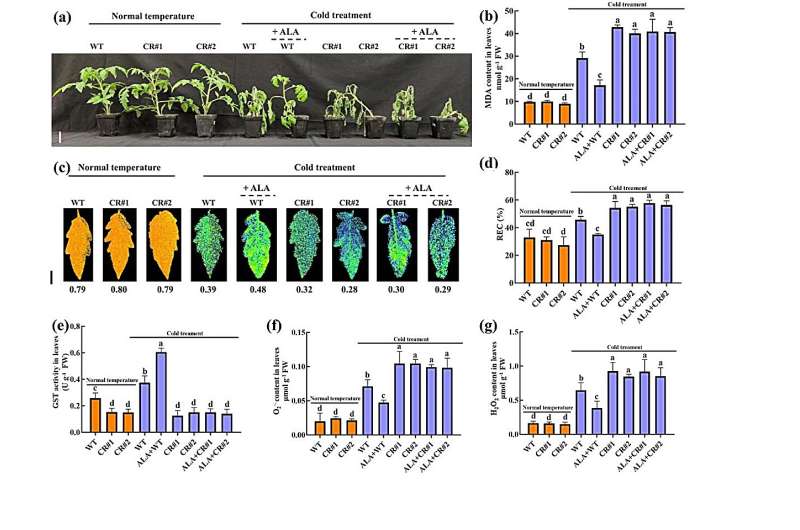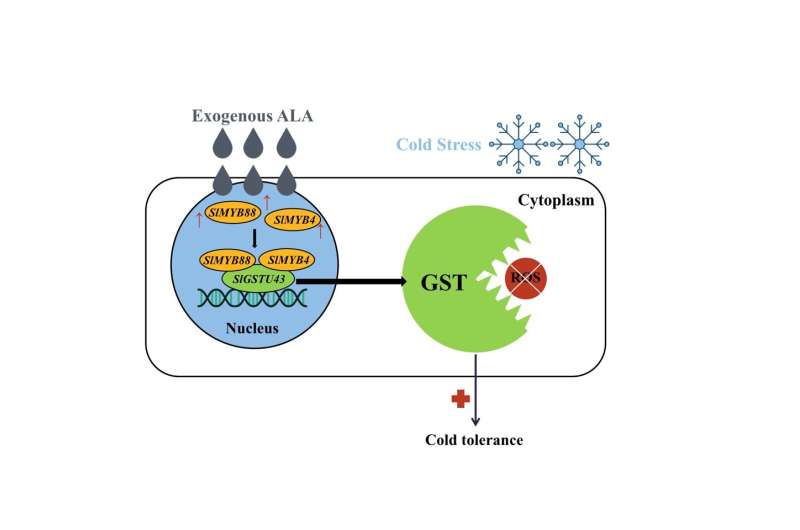This article has been reviewed according to Science X's editorial process and policies. Editors have highlighted the following attributes while ensuring the content's credibility:
fact-checked
peer-reviewed publication
proofread
Growth regulator 5-aminolevulinic acid enhances the cold resistance of tomato plants

Low temperature stress, as one of the main abiotic stresses, severely hinders plant growth and has adverse effects on crop yield and quality. 5-Aminolevulinic acid (ALA), a growth regulator widely present in animals and plants, has been extensively utilized in plant cold resistance processes due to its efficient, non-toxic, and easily degradable characteristics.
However, most of the current research related to ALA mainly focuses on the regulation network's end point. The specific molecular mechanism of ALA in early plant cold resistance is still unclear and requires further research by scientists.
In January 2024, Horticulture Research published a research paper titled "5-Aminolevulinic acid improves cold resistance through regulation of SlMYB4/SlMYB88-SlGSTU43 module to scavenge reactive oxygen species in tomato," completed by the team led by Hu Xiaohui from Northwest A&F University.
In this study, a glutathione S-transferase gene, SlGSTU43, was identified in tomato (Solanum lycopersicum L.). The research results indicate that ALA strongly induces the expression of SlGSTU43 under cold stress. Transgenic tomato lines overexpressing SlGSTU43 exhibited significantly enhanced ability to scavenge reactive oxygen species, showing clear resistance to low-temperature stress, whereas mutant lines of SlGSTU43 were sensitive to low-temperature stress.
Furthermore, the study results demonstrate that ALA did not enhance the tolerance of the mutant lines to low-temperature stress. Therefore, the research suggests that SlGSTU43 is an important gene in the process of ALA improving cold resistance in tomatoes (Fig. 1).

Furthermore, the study verified through EMSA, Y1H, LUC, and ChIP-qPCR assays that SlMYB4 and SlMYB88 can regulate the expression of SlGSTU43 by binding to its promoter. Further experiments demonstrated that SlMYB4 and SlMYB88 are also involved in the process of ALA enhancing tomato's tolerance to low-temperature stress, positively regulating the expression of SlGSTU43 (Fig. 2). These findings provide new insights into the mechanism by which ALA enhances tomato's tolerance to low-temperature stress.
More information: Zhengda Zhang et al, 5-Aminolevulinic acid improves cold resistance through regulation of SlMYB4/SlMYB88-SlGSTU43 module to scavenge reactive oxygen species in tomato, Horticulture Research (2024). DOI: 10.1093/hr/uhae026
Journal information: Horticulture Research
Provided by TranSpread




















